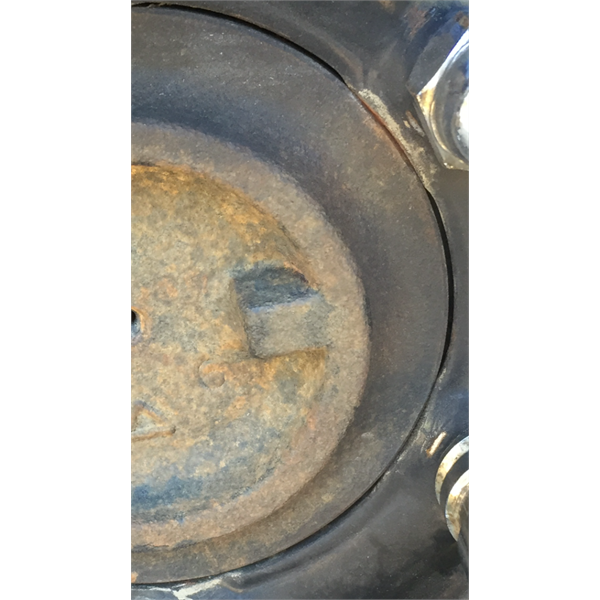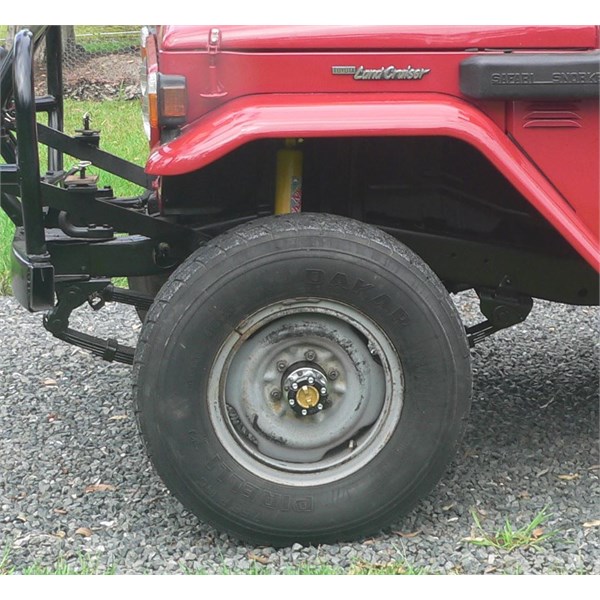Rim Fitment and stress points
Submitted: Friday, Oct 02, 2015 at 14:13
ThreadID:
130481
Views:
2762
Replies:
12
FollowUps:
5
This Thread has been Archived
mants
Hey all,
Ive recently got new King Rims fitted and when they were fitted i was told i need to get rings for behind the rim.
The tyre fitter said as it currently sits, when off roading there would be alot of pressure on the hub spindles that
the nut screws onto.
Ive spoke with the rim supplier and they say there is nothing made by King for steel rims.
So im sort of stuck at the moment as to what to do, and is it really a problem?
On the photo the green shows a gap which im not sure of and the red is the area where there is nothing behind between the spindles.
Reply By: mants - Friday, Oct 02, 2015 at 14:46
Friday, Oct 02, 2015 at 14:46
This is the hub
AnswerID:
591037
Reply By: garrycol - Friday, Oct 02, 2015 at 14:51
Friday, Oct 02, 2015 at 14:51
Spacers and adapters are illegal in australia for onroad use except where specified as oem fitment. If these rims require these then you are getting the wrong rims.
AnswerID:
591038
Follow Up By: mants - Friday, Oct 02, 2015 at 15:15
Friday, Oct 02, 2015 at 15:15
Hey mate,
Its definitely not a spacer im after as that would make the wheels sit out, which i dont want. its more of a strengthener im looking for
FollowupID:
859091
Follow Up By: Member - Broodie H3 - Friday, Oct 02, 2015 at 15:25
Friday, Oct 02, 2015 at 15:25
I am no tyre expert or wheel alinger, but I don't like the look of the gaps, if that was my vehicle I would say I have been supplied the wrong rims. but that is going off the photos not in real life. that is my 2 bobs worth
FollowupID:
859092
Reply By: andoland - Friday, Oct 02, 2015 at 16:14
Friday, Oct 02, 2015 at 16:14
By hub spindles I assume you mean the studs? The principal is that when you tighten the nuts onto the studs it is the friction between the rim and the hub (i.e. the flat surface on the back of the rim and the flat surface on the hub which mate together) which transmits the load. The studs are under tensile load only, they don't take any of the radial or torque load.
So
the gap that you refer to doesn't need to be filled.
AnswerID:
591050
Reply By: mants - Friday, Oct 02, 2015 at 17:16
Friday, Oct 02, 2015 at 17:16
Just got off the phone with the WA King Wheel supplier and he says that's the way it should be and there shouldn't be any problems with its as they've fitted these wheels to a good few Xtrails and haven't had any issues.
AnswerID:
591055
Reply By: Ross M - Friday, Oct 02, 2015 at 18:31
Friday, Oct 02, 2015 at 18:31
The hub "spindles" are studs!
If the fitter supplied the rims, they should not have sold them to you, if the centre spigot of the hub didn't closely engage with the rim inner dia.
It doesn't fit properly. Not only off road but on potholes at speed would be far worse in shearing off wheel studs.
If they sold them they aren't following a code on practice set out by the tyre and rim association and also the maker of the vehicle.
If you sourced the rims then a mistake has been made.
If it causes a wheel to leave the scene there won't be insurance IMHO. Not unless the assessor is blind.
AnswerID:
591063
Reply By: 671 - Friday, Oct 02, 2015 at 20:30
Friday, Oct 02, 2015 at 20:30
Mants
Go by what the wheel manufacturer says. I have been driving for over fifty years and none of my cars, both 2wd and 4wd , have had a wheel centre hole that actually touches the machined step in the hub. One car did not even have a centre hole in its standard steel wheels.
On my current car, a Toyota 4wd with its original steel wheels, there is a .005 to .006 thousands of an inch gap between the wheel centre hole and the step on the hub. It looks like the weight of the car is going straight from the hub to the wheel instead of via the studs but it is not. The studs are taking the lot.
First of all the clearance has to be there. If there was nothing you would need a press to get the wheel on and a puller to get it off.
If the wheel studs did not take all of the weight, there would be zero clearance at the bottom of the wheel centre hole and about .010" at the top. If that was to be maintained while the car was moving, the wheel mating surface would have to be sliding on the hub face. If that happened the wheel would work itself loose in no time.
The tapers on your wheel nuts and the matching tapers in the wheel stud holes in the wheel will centre the wheel on the studs as the nuts are correctly tensioned . The wheels will not move after that.
I have a second set of wheels fitted with street tyres for my car. They are from a Nissan Navara. My Toyota wheels have off road tyres. These Nissan wheels don't have a 5 to 6 thou clearance between wheel centre and hub, they have about 5 to 6 mm. I have been using them for seven years on sealed roads but they did unintentionally find themselves on the
Oodnadatta track during one trip.
Anybody can clearly see the wheel studs are taking the stress of everything from vehicle weight to braking to cornering. The nuts have never come loose and they certainly have not broken.
AnswerID:
591072
Reply By: TomH - Friday, Oct 02, 2015 at 20:32
Friday, Oct 02, 2015 at 20:32
I was always told that any replacement rims should mate up snug around the centre of the hub.
Have used lots of mags etc on different cars and ALWAYS they have mated up tight.
The explanation being that it centres the rim and helps take shocks off the wheel studs. Looks like they sold you rims with the wrong centres.
The guy is just worming out of his mistake.
AnswerID:
591073
Reply By: cruza25 - Friday, Oct 02, 2015 at 20:44
Friday, Oct 02, 2015 at 20:44
I think they sold you the wrong rims
The hole in the middle of the wheel should be snug on the spigot of the hub
Xtrail is 66.1 mm diameter
Take a wheel off and measure the hole in the middle
Cheers
Mike
AnswerID:
591075
Reply By: cruza25 - Friday, Oct 02, 2015 at 20:55
Friday, Oct 02, 2015 at 20:55
Just read this on tirerack website
Seems like there are several correct answers
The centerbore of a wheel is the machined opening on the back of the wheel that centers the wheel properly on the hub of a vehicle. This hole is machined to exactly match the hub so the wheels are precisely positioned as the lug hardware is torqued down. Keeping the wheel precisely centered on the hub when it is mounted will minimize the chance of a vibration. Some wheels are vehicle model specific and will come from the factory with a
bore machined to match that vehicle. Some wheels are designed to fit multiple vehicle models and will use a centering ring system to reduce the
bore size to match the hubs of different vehicles. These rings keep the wheel precisely positioned as the lug hardware is torqued down.
Some wheels are non-hub centric by design. These are known as lug centric wheels. With these wheels it is critical to torque the lug hardware with the vehicle on jack stands, off the ground. This allows the nuts or bolts to center the wheel and torque down without the weight of the vehicle pushing them off center.
AnswerID:
591077
Follow Up By: Member - Bigred13 - Friday, Oct 02, 2015 at 21:13
Friday, Oct 02, 2015 at 21:13
Cruza25 ,spot on with your last paragraph ,says it all ,never have changed a truck tyre with the hub sung fit with rim ,and they take more stress than a fourby.
John
FollowupID:
859136
Follow Up By: 671 - Saturday, Oct 03, 2015 at 11:15
Saturday, Oct 03, 2015 at 11:15
cruza25
I also agree with your last paragraph. All wheel stud holes are a loose fit over the studs. You cant expect the tapered nuts to lift the weight of the car as they try and centre the wheels on the studs.
I noticed the two sets of wheels on my car have a centre
bore hole that has been punched out, not accurately machined. I have a couple of BA Falcon wheels that are the same.
I also have a second Hilux ( a 1991 model) that I bought from a neighbor three weeks. He has owned it for around fifteen years and has driven it countless times between
Sydney and his opal nine at The Sheepyards just out of Lightening Ridge NSW. Its 15" aftermarket wheels with 31" tyres have a centre
bore hole that is a at least 10mm larger than the matching
seat on the hub.
These wheels may have been on the car since new because the spare is an original Toyota steel 16" fitted with a never used Dunlop SP Road Gripper 205R16C LT. The only thing that I can find on it that looks like a manufacturing date tag has AO41 on it. That may be the
forth week or month of 1991.
FollowupID:
859169
Reply By: cruza25 - Friday, Oct 02, 2015 at 21:10
Reply By: Michael ( Moss Vale NSW) - Monday, Oct 05, 2015 at 09:20
Monday, Oct 05, 2015 at 09:20

Patrol rear hub
The Patrol standard rims fit very neat around the hub diameter, it makes good engineering practice. Also they have a raised ring pressed into the rim around the six stud holes to act as a spring to maintain tension. A lot of aftermarket rims are flat in that area and many have incorrect stud hole size and poorly machined or pressed tapered areas for
the nut to
seat on. I looked at different rims years ago when deciding what to get to replace my Nissan alloys. I ended up sticking with standard steel rims. Michael
AnswerID:
591183
Reply By: Member - Scott M (NSW) - Monday, Oct 05, 2015 at 09:49
Monday, Oct 05, 2015 at 09:49
My old splitties, but the same set up on my tubeless - makes it easier to lift the spare on - just lift over the hub.

rims
AnswerID:
591186
Follow Up By: 671 - Monday, Oct 05, 2015 at 15:40
Monday, Oct 05, 2015 at 15:40
The original splits on my Hilux look exactly the same but when the nuts are tightened, there will be a tiny measurable gap between the wheel and the hub. That gap has to be there so you can get the wheel on and off and it does not disappear when the nuts are tightened. I have yet to hear anyone explain how the vehicle weight can go directly from the hub to the bottom of the hole in the wheel when the two do not touch.
FollowupID:
859280